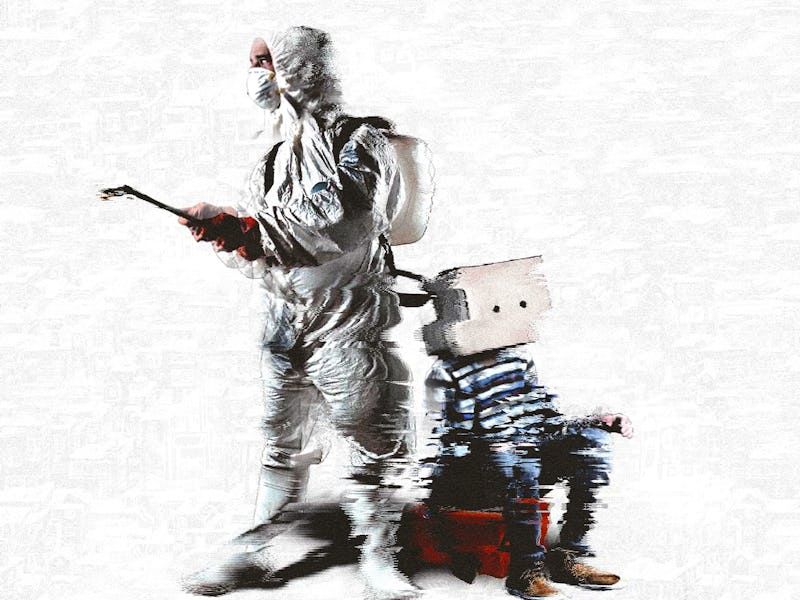“I Haven't Seen Someone Else’s Face in a While.”
How an unknown Peruvian director predicted Covid-19 by mistake.

Brushing blood off a road in the early morning hours, Eusebio (Víctor Prada) removes the remnants of a scene where a man committed suicide by throwing himself in front of a car. A definitive decision for the deceased turns into nothing more than a quotidian task for Eusebio, who earns a living cleaning the aftermath of gruesome incidents in Lima, Peru.
That premise alone would constitute the basis for a compelling character study, but writer-director Adrián Saba chose to turn The Cleaner (El Limpiador) into an even more singular entry in the history of Peruvian cinema by making his 2012 debut a dystopian sci-fi drama.
Alarming news reports warn of a mysterious respiratory illness that’s spreading fast. Those who contract it die within 12 hours of showing symptoms. The virus disproportionately affects men more than women, but, for an unexplained reason, it doesn’t infect children.
The crisis has increased Eusebio’s workload. During one of his assignments, he discovers 8-year-old Joaquin (Adrian du Bois) hiding in a closet. The kid’s mother has died, and his father is nowhere to be found. With no room for him at shelters overcrowded with parentless minors, Eusebio must take care of Joaquin until he can locate a relative.
Joaquin (Adrian du Bois) and Eusebio (Víctor Prada).
If you watched this setup without knowledge of when the film was released, it would make sense to assume it was inspired by the 2020 Covid-19 pandemic. But Saba shot El Limpiador when he was 22 years old, using as main references the outbreak of swine flu that afflicted Mexico in 2009 and a documentary he watched on TV about people who work in death scene cleanup.
There’s a sobering quality to Saba’s first feature, which represented Peru at the Oscars in the Best International Feature Film category. Each decision feels meticulously subdued. There’s no urgency in explaining the mechanics of the plague but a focus on behavior that reveals how these two characters slowly connect.
That this young filmmaker dared to dabble in genre storytelling with little precedent in his homeland served as the production’s key attention-grabbing feature. Peru’s limited film output is dominated by broad comedies with local audiences in mind, though occasionally, more traditional social realist dramas land slots at international festivals.
Gray in color and lifeless in ambience, Eusebio’s home reeks of loneliness. Accustomed to only his own company, the introverted middle-aged man is ill-prepared to deal with an orphaned child who constantly verbalizes his fear of dying and other existential worries. To ease the boy’s anxieties about the world’s dangers — Joaquin refuses to leave the cupboard at first — Eusebio fashions a makeshift mask/helmet out of a cardboard box for him to wear.
Eusebio and Joaquin eating their meals together in the residence’s sparse kitchen.
Saba makes it clear that his adult protagonist suffers from a similar aversion to stepping out of his comfort zone. Even among other cleaners, Eusebio sits alone, unable or unwilling to communicate. Working with few lines of dialogue, Prada puts forward a muted performance showing subtle indications of newfound joy as Eusebio warms up to Joaquin.
That Saba makes a point of noting men more easily fall victim to the disease suggests he is linking their physical debility to their lack of emotionally fulfilling relationships. Eugenio visiting his senile father at a nursing home is his attempt at course-correcting that void.
Desolate locations establish a convincing, otherworldly atmosphere.
Empty trains and desolate locations — a soccer stadium or the airport — help Saba establish a convincing, otherworldly atmosphere. Using formidably composed static frames, cinematographer César Fe shoots the characters often in wide shots that visually amplify their smallness against the spacious locations with few other humans ever in sight.
“I haven't seen someone else’s face in a while,” a concerned lady tells Eusebio and Joaquin when she questions why they travel on the train without face masks. She then assumes the two are father and son and comments on how their downhearted stares seem identical.
Poster art for The Cleaner.
Using the genre framework as a catalyst, Saba devised a plot where the moments he really cares about can exist naturally: Eusebio and Joaquin eating their meals together in the residence’s sparse kitchen or the two of them touring cemeteries in the Peruvian capital without distracting factors. Certain sequences are scored with the distant sound of barking dogs, perhaps pets abandoned by owners who are now gone forever, highlighting the notion that we are somewhere between normalcy and chaos.
The horrors of the disease that wiped out most of the population ultimately fade into the background as the narrative evolves into a story of absent fathers and hurting sons, where a sad man becomes putative caretaker to a boy just as tormented by immense solitude. In the silence of a city decimated by death, unlikely companionship blossoms.
This article was originally published on